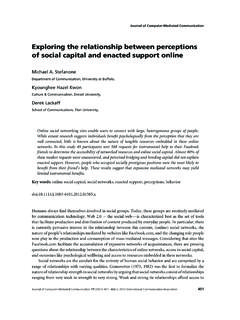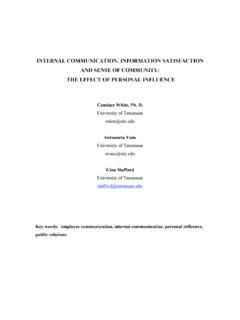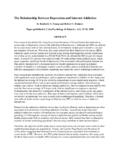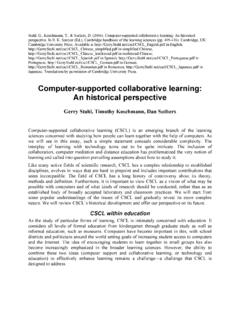Transcription of Theories of Computer- Mediated Communication …
1 443 CHAPTER 14 Theories of Computer- Mediated Communication and Interpersonal RelationsJoseph B. WaltherComputer- Mediated Communication (CMC) systems, in a variety of forms, have become integral to the initiation, devel-opment, and maintenance of interpersonal rela-tionships. They are involved in the subtle shaping of Communication in almost every relational context. We may observe or participate in the conversations of huge numbers of social actors, from the Twitter messages of experts we have never met to one s family s blog and from mes-saging a barely acquainted Facebook friend to coordinating with one s spouse through texting about who will pick up the kids that day or say-ing via e-mail that one is sorry about the fight they had that morning.
2 Individuals exploit the features of these media to make their best impres-sion and attract attention or to ward off unde-sired contacts (Tong & Walther, 2011a). We continually form and re-form our impressions and evaluations of others online, from deciding whose recommendations to trust in discussion boards (Van Der Heide, 2008) to evaluating the friend who portrays himself online in a not quite accurate way (DeAndrea & Walther, in press). Although many people perceive that social media messages are trivial and banal, so is the stuff by which relationships are maintained (Duck, Rutt, Hurst, & Strejc, 1991; Tong & Walther, 2011b).The ubiquity of CMC is not sufficient impetus for it to be a focus of study in interpersonal com-munication research.
3 How CMC changes our messages how they are constructed, whether for specific relational purposes or with lesser or greater effect remain important questions that continue to drive inquiry in interpersonal CMC research. How does the Internet affect the likeli-hood of having relationships? With whom? And how do we manage these relationships? How do disclosures and affectations influence others and ourselves, and how do online interpersonal pro-cesses affect the instrumental and group dynam-ics that technology enables? How do we exploit existing technologies for relational purposes, and how do we evade the potential dampening effects that technologies otherwise may impose on relational Communication ?
4 How do technology 444 PART IV: Processes and Functionsdevelopers incorporate features into communica-tion systems specifically designed to support and enhance relational functions?There are many methodologies employed in studying CMC and social interaction. Large-scale, sophisticated surveys enumerate what people are doing online and why they say they are doing them ( , Katz & Rice, 2002; the Pew Internet & American Life Project at ). There are accounts of the metaphors that define the online experience for Internet date seekers ( , Heino, Ellison, & Gibbs, 2010) and interpre-tive investigators insights from interacting with groups of young people about what is going on and what it means online (boyd, 2007).
5 Conference proceedings from design experiments report cog-nitive and affective responses to variations in the representation of others online behaviors or dif-ferent interface characteristics with which to behave online ( , the ACM Digital Library at ). A number of recent and forthcoming volumes address different aspects of interpersonal interaction online, including works by Amichai-Hamburger (2005), Baym (2010), Joinson, McKenna, Postmes, and Reips (2007), Konijn, Utz, Tanis, and Barnes (2008), Papacharissi (2010), Whitty and Carr (2006), and Wright and Webb (2011), among oth-ers. Any of these approaches provide glimpses into the changing landscape of interpersonal Communication and CMC.
6 No one chapter can paint this landscape or summarize it well. Worse yet, such an amalgamation of facts would suffer from a lack of coherence, reflecting a field with more work being done than consensus on what work should be done. Moreover, to describe what people are doing interpersonally with CMC today would be to invite obsolescence very quickly, given the pace of change in Communication and technology. Readers who expect such an account-ing in this essay will be , despite the field s youth, there are now a greater number of theoretical positions directly related to CMC than any single overview of the field has previously described. Some theo-ries have matured and are due for evaluation, both in light of a number of empirical tests of their validity, and intensions and extensions of their explanatory power.
7 New technological developments may have enlarged or diminished their relative scope. Newer Theories have also arisen, some barely tested, the ultimate utility of which remains to be seen. This is not to suggest that the only Theories the field needs are those focusing specifically on CMC. As Yzer and Southwell (2008) suggested, the most useful explanations of CMC may be those that rest strongly on robust Theories developed in tradi-tional contexts. For the present purposes, the chapter focuses on CMC-specific theoretical for-mulations. As Scott (2009) observed, We can t keep up with new innovations, so we need theory and models that can (p. 754).This chapter provides, first, a description and evaluation of 13 major and minor Theories of CMC.
8 Although readers may find many of these approaches reviewed in other sources, particular efforts have been made to review the Theories development and status since the publication of the previous edition of this Handbook (see Walther & Parks, 2002). These Theories are classi-fied according to their conceptualization of the way users respond to the characteristics of CMC systems, particularly in the adaptation to cue systems that differ from face-to-face communi-cation. These Theories include the now standard classification of cues-filtered-out Theories , which assert that systematic reductions in the nonverbal cues conveyed by different Communication sys-tems lead to impersonal orientations among users.
9 There are differences among the foci of impersonal orientations, some of which are aso-cial and others quite specific and social in nature. The second group of Theories depicts how charac-teristics of communicators, their interactions with others, and contextual factors affect the perceived capacities of different Communication systems. These perceptions, in turn, affect the expressiveness and normative uses of these same technologies as if the capacities themselves had changed. The next set of Theories reflects the ways in which communicators adapt to or exploit Chapter 14: Computer- Mediated Communication and Interpersonal Relations 445the cue limitations of CMC systems to achieve or surpass face-to-face levels of affinity.
10 Finally, new theoretical ideas are mentioned that address the utility of different media over the progression of usage sequences or relational stages or compare media effects of different kinds based on the rela-tive effortfulness of different channels. The dis-cussion includes numerous examples from research that help exemplify critical findings related to these chapter ends with a few notes of concern about trends in contemporary CMC research. These trends represent understandable develop-ments given the nature of the field, yet they also present potential problems in the further devel-opment of knowledge in certain domains. These concerns involve the role of face-to-face com-parisons in technology-focused research, the potential impact of new technologies on earlier CMC Theories , and the implications of multimo-dality in relationships ( , how to learn about the usage of a variety of Communication systems within any single relationship).








